
|

|
Viking Age Arms and Armor
Viking Spear
 |
Much of the text presented on this page is out-of-date. Until we find time to make the needed updates to this page, we strongly encourage readers to look at this topic as it is presented in our new book, Men of Terror, available now from your favorite book seller. |
 |
The spear was the most commonly used weapon in the Viking age. During this time, spear heads took many forms. The photo to the left shows a modern reproduction, typical of the late Viking age. The top photo to the right shows an 11th century spearhead, while the bottom photo to the right shows a 10th century spearhead. Earlier spearheads were about 20cm (8in) long, while later ones were as long as 60cm (24in). In chapter 55 of Laxdćla saga, Helgi had a spear with a blade one ell long (about 50cm, or 20in). He thrust the blade through Bolli's shield, and through Bolli. The photo below shows an assortment of Viking era spear heads, illustrating the variations in size and shape. The top-most spearhead in the photo is 38cm (15in) long, giving a sense of scale.
In chapter 8 of Króka-Refs saga, Refur made a spear for himself which could be used for cutting, thrusting, or hewing. Refur split Ţorgils in two down to his shoulders with the spear. Some spear heads, including all those in the photo above, had "wings" on the head, useful for a variety of tricks. These are called krókspjót (barbed spear) in the stories. Grettir used a barbed spear with a blade so thin and long that he was able to pierce all the way through Ţórir and into Ögmundur with a single thrust, right up to the wings. Both men were killed by the thrust, as is told in chapter 19 of Grettis saga. |
|
Some spearheads were quite small, seen both in the archaeological finds (right), and in the sagas. Laxdćla saga (chapter 64) said that Hrappr carried a spjótsprika, sometimes translated as "puny spear". |
 |
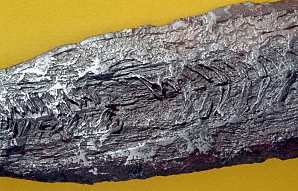 |
The spearheads were made of iron, and, like sword blades, were made using pattern welding techniques (described in the article on swords) during the early part of the Viking era (left). They were frequently decorated with inlays of precious metals or with scribed geometric patterns (right). |
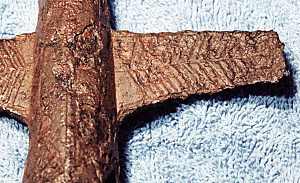 |
In cross-section, spear heads were lozenge shaped, with a thick central rib, clearly visible in the 10th century spearhead shown to the right. The head tapered smoothly to a sharp edge on either side of the rib. |
 |
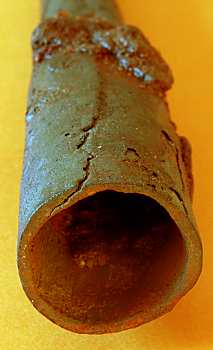 |
After forming the head, the smith flattened and drew out material to form the socket (right). This material was formed around a mandrel and usually was welded to form a solid socket. In some cases, the overlapping portions were left unwelded. The overlap in the socket of a 10th century spear is shown to the left. |
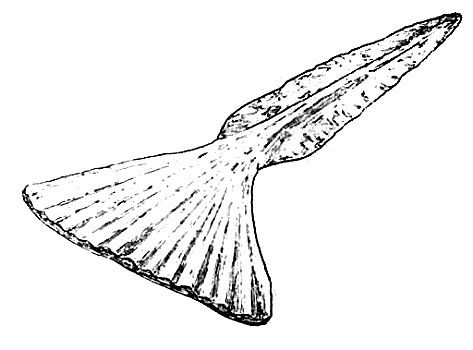 |
|
The historical Viking age spear head shown above was clearly a magnificent work of art at one time. Although most of the decoration has fallen off in the intervening years, the close-up to the right shows inlaid copper and silver on the rib, and leafy foliage decorations on the surface of the blade, which at one time, covered the blade. |
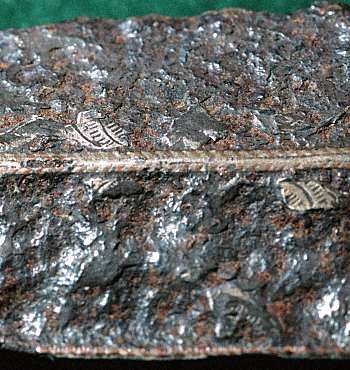 |
 |
Spear heads were fixed to wooden shafts using a rivet. The sockets on the surviving spear heads suggest that the shafts were typically round, with a diameter of 2-3cm (about one inch). However, there is little evidence that tells us the length of the shaft. The archaeological evidence is negligible, and the sagas are, for the most part, silent. Chapter 6 of Gísla saga tells of a spear so long-shafted that a man's outstretched arm could touch the rivet. The language used suggests that such a long shaft was uncommon. The reproduction spear on the left has a shaft of that length, while the other spear in the photo has a shorter shaft. Perhaps the best guess we can make is that the combined length of shaft and head of Viking age spears was 2 to 3m (7-10ft) long, although one can make arguments for the use of spears having both longer and shorter shafts. A strong, straight-grained wood such as ash was used. |
Whatever the typical length might have been, a story from chapter 15 of Fóstbrćđra saga suggests that the amount of wood was not insubstantial. Gaut's men ran out of firewood while cooking their meal. Gautr went to Ţorgeir's tent and broke up his spear shaft and shield to provide firewood sufficient to cook the meal. Ţorgeirr seemed unperturbed when he returned to the camp and discovered his weapons were missing, but he later returned the favor by splitting Gautr apart down to his shoulders using his axe.
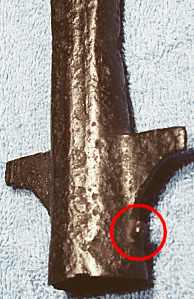 |
There are examples in the sagas of spear shafts reinforced with iron. In chapter 40 of Vatnsdćla saga, it is said that Ingólf's spear had a broad blade and a shaft reinforced with iron. In other historical periods, the far end of the spear shaft was covered with a metal butt cap, to help protect the wooden shaft and to help balance the weapon. The evidence for the use of these caps in the Viking age is very slight, so if they were used, they were not common. The rivets that attached the spear head to the shaft on surviving historical weapons are surprisingly small, as shown in the photo to the left. The rivet head is circled in red and is shown in more detail to the right. |
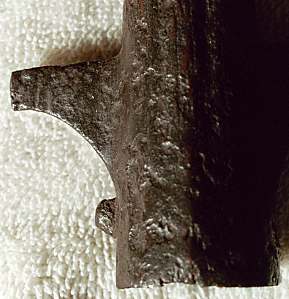 |
|
A passage from chapter 48 of Grettis saga suggests that the rivet could easily be removed with whatever tools people normally carried with them. Grettir arrived at Ţorbjörn's farm, Ţoroddstađir, to take revenge on Ţorbjörn for his killing of Grettir's brother, Atli. After Grettir arrived at the farm, he sat down and removed the rivet to prevent Ţorbjörn from throwing the spear back at him. The head flew off when Grettir threw the spear. After killing Ţorbjörn and his son with his sax, Grettir searched for the spearhead, but couldn't find it. According to the saga, the spearhead was found in the marshland behind the farm centuries later (shown to the right, as it appears today). The saga author says that people alive at the time the saga was written could remember the spearhead being found. A speculative reconstruction of how a spear with a pulled nail might be used is shown in the combat video demo, part of a longer fight. |
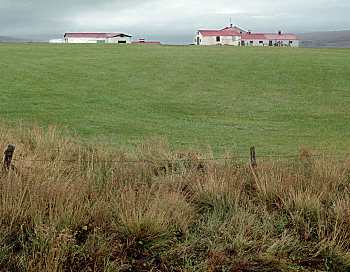 |
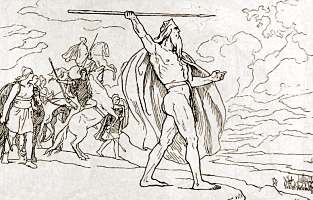 |
Many people think of the spear as a throwing weapon. One of the Norse myths tells the story of the first battle in the world, in which Ođin, the highest of the gods, threw a spear over the heads of the opposing combatants as a prelude to the fight. |
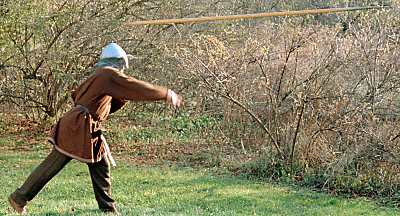 |
The sagas say that spears were also thrown in this manner when men, rather than gods, fought. At the battle at Geirvör (shown to the right as it appears today) described in chapter 44 of Eyrbyggja saga, the saga author says that Steinţórr threw a spear over the heads of Snorri gođi and his men for good luck, according to the old custom. |
 |
|
While spears were certainly used as missiles during the Viking age, there's a disadvantage to throwing your weapon away in a fight. Not only do you lose your weapon, but you risk having your opponent pick it up and use it against you if you miss. Worse, your weapon may be caught in flight and flung back at you, a move used on several occasions by Gunnar (e.g., Brennu-Njáls saga chapter 54). A speculative reconstruction of this move is shown in this combat video demo, part of a longer fight. Since it was shameful in the extreme to be hit by your own weapon, a clever fighter such as Gunnar would look for opportunities to kill and dishonor with one move. |
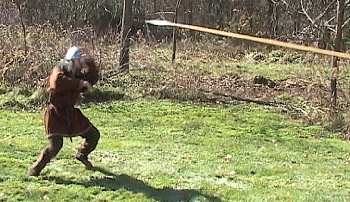 |
|
|
Despite these risks, the sagas are filled with examples where spears were thrown, such as chapter 145 of Brennu-Njáls saga. Spears were also used with "throwing strings" (snćrisspjót) for longer reach, such as in chapter 24 of Reykdćla saga og Víga-Skútu where Skúta shot a spear across a river ford, killing Ţrándur. The string allows the hand and body to accelerate the spear for a longer period of time, even after the spearshaft has left the hand. We recently did some tests showing that, on average, a snćrisspjót flew with almost 50% more speed than a conventional spear, and that when it hit a solid target, the snćrisspjót delivered more than twice the impact to the target than a conventional Viking spear. The slo-mo video (left) shows that compared to a normal spear (top), a snćrisspjót (bottom) has substantially more spin as it flies, suggesting it flies with greater accuracy. |
More commonly, the spear was used as a thrusting weapon. The sagas tell us thrusting was the most common attack in melees and one-on-one fighting, and this capability was used to advantage in mass battles. In a mass battle, men lined up, shoulder to shoulder, with shields overlapping. After all the preliminaries, which included rock throwing, name calling, the trading of insults, and shouting a war cry (ćpa heróp), the two lines advanced towards each other. When the lines met, the battle was begun. Behind the wall of shields, each line was well protected. Once a line was broken, and one side could pass through the line of the other side, the battle broke down into armed melees between small groups of men.
Before either line broke, while the two lines were going at each other hammer and tongs, the spear offered some real advantages. A fighter in the second rank could use his spear to reach over the heads of his comrades in the first rank and attack the opposing line. Konungs skuggsjá (King’s Mirror), a 13th century Norwegian manual for men of the king, says that in the battle line, a spear is more effective than two swords.
When the line broke, stories say that people would sling their shields over their shoulders and use the spear two-handed, something that Ţórolfr did in chapter 53 of Egils saga. Used this way, the spear has even more reach, since the fighter can bring his hands way back towards the butt end of the spear.
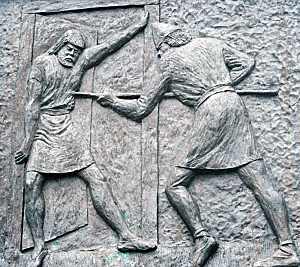 |
This technique works well in single combat, as well. In chapter 45 of Grettis saga, Ţorbjörn knocked loudly on the door at Atli's farm, then hid. When Atli went to the door, Ţorbjörn rushed up holding his spear in two hands and ran Atli through. When he took the blow, Atli said, "Broad spears are in fashion these days," and fell dead. |
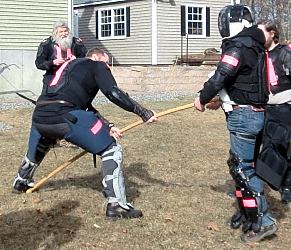 |
Some practitioners allow the spear shaft to slide so that both hands are at the butt end of the shaft during a thrust, allowing the spear to reach the full extent of the shaft in a lunge (right), greatly extending the reach of the thrust. The spear is too easy to knock off-line when used this way, and we don't recommend the move. When used two handed, the spear provides the combatant with enough leverage to lift his opponent up off his feet, impaled on the tip of spear, according to the sagas. Ţórólfur did just that with Earl Hring in chapter 53 of Egils saga. Our attempts to replicate this feat have not been completely successful (left), but we are getting close! Perhaps we lack Ţórólfur's strength. |
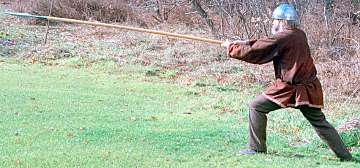 |
In addition to being used for thrusting, the sagas also tell us that spears were used for cutting. Króka-Refr made his own spear, as is told in chapter 8 of Króka-Refs saga. Later in the chapter, Refr repaid Ţorgils for some earlier slander by splitting him in two down to his shoulders with the spear.
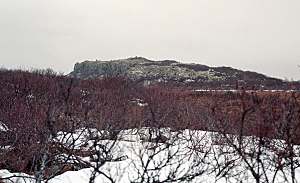 |
The sagas also show us a significant disadvantage to a spear: their length made them easy to spot, and a number of ambushes were thwarted by sharp-eyed men seeing the spearheads glinting in the distance. Egils saga (chapter 83) says that a sharp-eyed shepherd spotted some spearheads from the top of the hills Einkunnir (left as they appear today), and he warned Ţorsteinn Egilsson. Rather than facing his ambushers, Ţorsteinn acted the coward and made up an excuse to turn and ride off in another direction. |
A spear is a surprisingly quick weapon. A spearman can keep a swordsman very busy, thrusting or flicking the point from face to belly and back again, while staying out of range of the sword. However, a spearman would need to be wary that anyone armed with a sword didn't find his way past the point of the spear. Once past the point, the swordsman would have every advantage. A speculative reconstruction of a spearman fighting a man armed with sax and shield is shown in this combat demo video, part of a longer fight. The spearman keeps the sax fighter very busy, while the sax fighter tries multiple times to get past the point of the spear to make an attack. What finally works is for the sax fighter to control the spear shaft with his shield while running in to attack, although the spearman is ready with a surprise.
Fighters with bladed weapons might be surprised in other ways while running in and controlling the spear shaft with the shield. The stories say that fighters armed with swords had the ability to cut a spear shaft in two with their sword, rendering the spear useless. For instance, in chapter 31 of Finnboga saga ramma, as Jökull thrust at Ţorkell with a spear, Finnbogi cut the spear shaft in two with his sword.
|
One approach that seems to work well when a swordsman faces a spearman is for the swordsman to adopt the inside ward with his shield, inviting an attack. |
|
|
When the spearman thrusts, the swordsman can move to outside ward, deflecting the thrust. |
|
|
The swordsman steps in behind the shield, and places himself in a perfect position to lop off the head of the spear. From here, the swordsman is well situated to control the shaft of the spear with his shield as he closes the distance to attack the spearman. |
|
The spearman, now holding a stick, still has many good options; the fight is not yet over. For example, he could step out, choke up, and use the butt end of the spear against the swordsman. The spearman might have avoided having his spearhead lopped off in the first place by shortening his grip, bringing his spear under the shield, and attacking the other side.
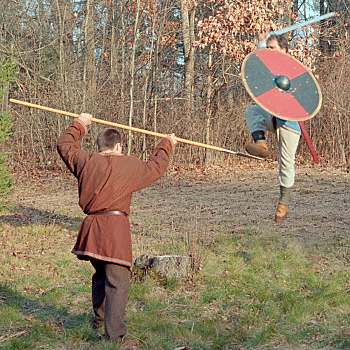 |
One response to a spear thrust is to jump over it. Kári Sölmundarson used this trick on many occasions in Brennu-Njáls saga, jumping up and over an incoming spear shaft. In chapter 146, Kári jumped up as Lambi lunged at him with a spear. Kári landed on the spear shaft, breaking it. In Eyrbyggja saga (ch.45), Freysteinn bófi lunged at Steinţórr with his spear, aiming for his middle. Steinţórr, while protecting Ţórđur with his shield and cutting to Ţorsteinn's leg with his sword, leapt into the air and the spear passed between his legs. An interpretation of the trick of jumping over an incoming spear is shown in this combat demonstration video, part of a longer fight. |
Spears were occasionally used in other ways in combat. In chapter 16 of Reykdćla saga og Víga-Skútu, Steingrímur and his men were battling Áskell and his men, who were on a bank above the frozen river. Helgi used his spear shaft to vault over the ice and up onto the bank where Áskell and his men were fighting. It didn't do him much good, since Háls killed him immediately. In chapter 6 of Fóstbrćđra saga, Ţorgeirr watched from the top of a snowy ridge as Bultradi made his way up the slope for a fight with Ţorgeirr. Bultradi cut steps in the hard, frozen snow with his axe as he worked his way up the hill. Ţorgeirr set his spear underneath him on the snowy hill, with the spear point facing down the slope. Ţorgeirr slid down the slope on his spear and drove his axe into Bultradi's chest as he whizzed by.
 |
Fortifications were sometimes entered by raising a man on his shield using spear-points (left), as described in chapter 5 of Gull-Ţóris saga. Ţórir dug his axe into the wall of the fortification to pull himself up over the top, a move described in more detail in the Viking axe article. |
|
|
<< Previous article |
Back to Arms and Armor |
Next article >> |
|
©1999-2025 William R. Short |